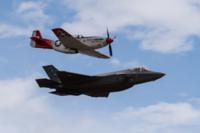For nearly two weeks in October 1962, the world stood on the brink of nuclear annihilation. American medium-range nuclear missile deployments in Turkey prompted the Soviet Union to place medium-range weapons of its own in Cuba.
When the United States discovered the missile sites, President John F. Kennedy and his staff debated a response to the Soviet threat. Any misstep might have led to a nuclear exchange that would kill millions. In the end, the only casualty was Maj. Rudolf Anderson, a U-2 spy plane pilot whose work led to a peaceful resolution of the crisis.
Anderson joined the Air Force after completing ROTC training as a student at Clemson University. Although he entered the service in 1951, he wouldn't earn his pilot's wings in time to fight in the Korean War. After the war ended, he flew missions from South Korea and Japan, earning two Distinguished Flying Crosses.
After qualifying on the then-secret U-2 reconnaissance plane in 1957, Anderson was transferred and began flying top-secret missions over Cuba. His unit, the 4080th Strategic Reconnaissance Wing, took the photos that discovered the secret Soviet nuclear launch sites under construction there. Maj. Anderson captured photos of the sites on Oct. 14, 1962.

On Oct. 15, CIA photo analysts discovered the evidence of those sites on the island. The next day, President Kennedy was briefed on the situation and began to convene meetings about what to do next. His advisers were divided about how to proceed, but the one thing they did agree on was that the missiles were a legitimate threat.
Among the military choices they considered was a full U.S.invasion of Cuba to overthrow President Fidel Castro and remove the missiles. The military also came up with a plan that would strategically eliminate the sites. A third option was to blockade the island to prevent more missiles and materiel from reaching the launch sites.
As negotiations with the Soviet Union continued, Kennedy opted for the blockade, which went into place on Oct. 22. Officially called a "quarantine" of offensive weapons, any ships bound for Cuba carrying weapons would be turned back to their home port. The U.S. military raised its alert status to DEFCON 3.
Two days later, Soviet leader Nikita Khrushchev called the blockade "piracy" in a telegram to Kennedy, saying any intervention of a Soviet ship would lead to war. The United States responded by going to DEFCON 2 on Oct. 26. B-52 bombers were placed on continuous airborne alert, reservists were recalled and the U.S. nuclear arsenal was put on alert status.
On Oct. 27, 1962, Maj. Rudolf Anderson took off from Cuba in a U-2F Dragon Lady to make his sixth overflight of the island. It would be his last. As he flew over Banes, Cuba, his aircraft was hit by shrapnel from a Soviet-built Dvina surface-to-air missile (SAM). The fragmentation shredded his high-altitude pressure suit.

Castro, fearful of a U.S. invasion, had ordered all Cuban SAM sites to fire on American aircraft in Cuban airspace. With the shootdown of Anderson's U-2, negotiations began to intensify, but Kennedy didn't respond militarily. Secretly, the two sides would agree to remove American missiles from Turkey in exchange for the Soviets removing the missiles from Cuba.
The shooting down of Anderson's U-2 was one of many close encounters that might have led to an escalation and nuclear war during the Cuban Missile Crisis, but in the end, Anderson would be the only casualty. His remains were retrieved by the Cuban government and released to the United Nations. He was buried near his hometown of Greenville, South Carolina.
In 1964, under Kennedy's orders, Anderson was awarded the first of a new medal created in 1960. It is still the Air Force's second-highest award for heroism in combat: the Air Force Cross.
-- Blake Stilwell can be reached at blake.stilwell@military.com. He can also be found on Twitter @blakestilwell or on Facebook.
Want to Learn More About Military Life?
Whether you're thinking of joining the military, looking for post-military careers or keeping up with military life and benefits, Military.com has you covered. Subscribe to Military.com to have military news, updates and resources delivered directly to your inbox.
















